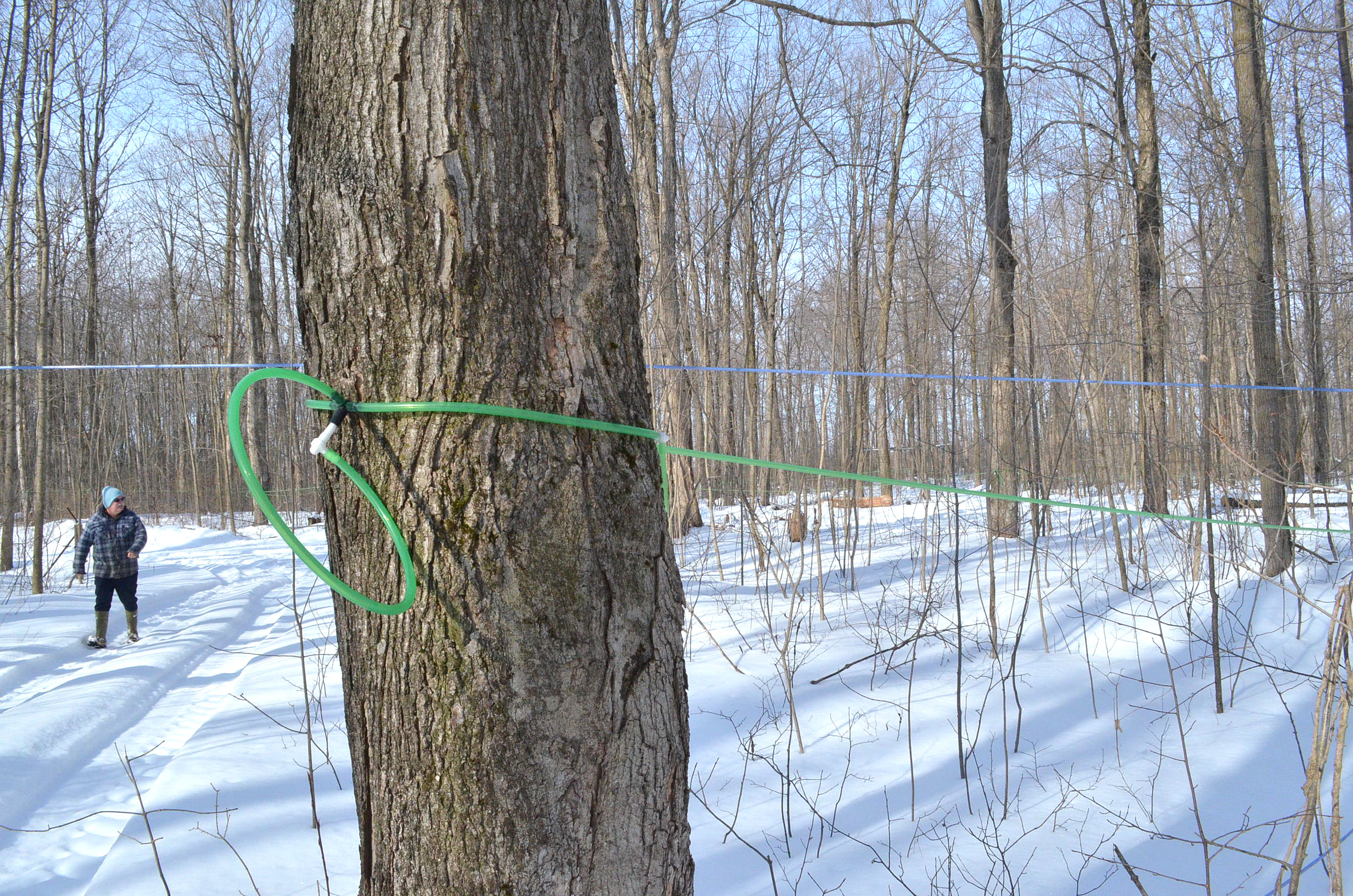Terry Hoover kills the engine of his Kubota utility vehicle and climbs out of the cab into the cool but comfortable early February air. It’s mid-morning and the sun is beginning to warm the frozen landscape, as he stands in his expansive sugar bush just north of Atwood and quietly takes in the scene around him before getting down to brass tacks for the day.
Aside from the occasional twitter of a bird or creak of a tree, it’s completely silent. This is Hoover’s office and laboratory all rolled into one, and he wouldn’t have it any other way.
“No matter how early in the day I come back here, somebody has already been out ahead of me. And you can tell by the tracks,” says Hoover, 62, gesturing to the criss-crossing of prints across the glistening white snow. Tracks from rabbits, squirrels, deer, wild turkey and foxes are all evident. “This is just like Grand Central here.”
For over three decades, Hoover and his wife, Diane, have been in the business of attempting to achieve perfection. Perfection in the form of everyone’s favourite breakfast condiment – that sticky amber delicacy known as maple syrup.
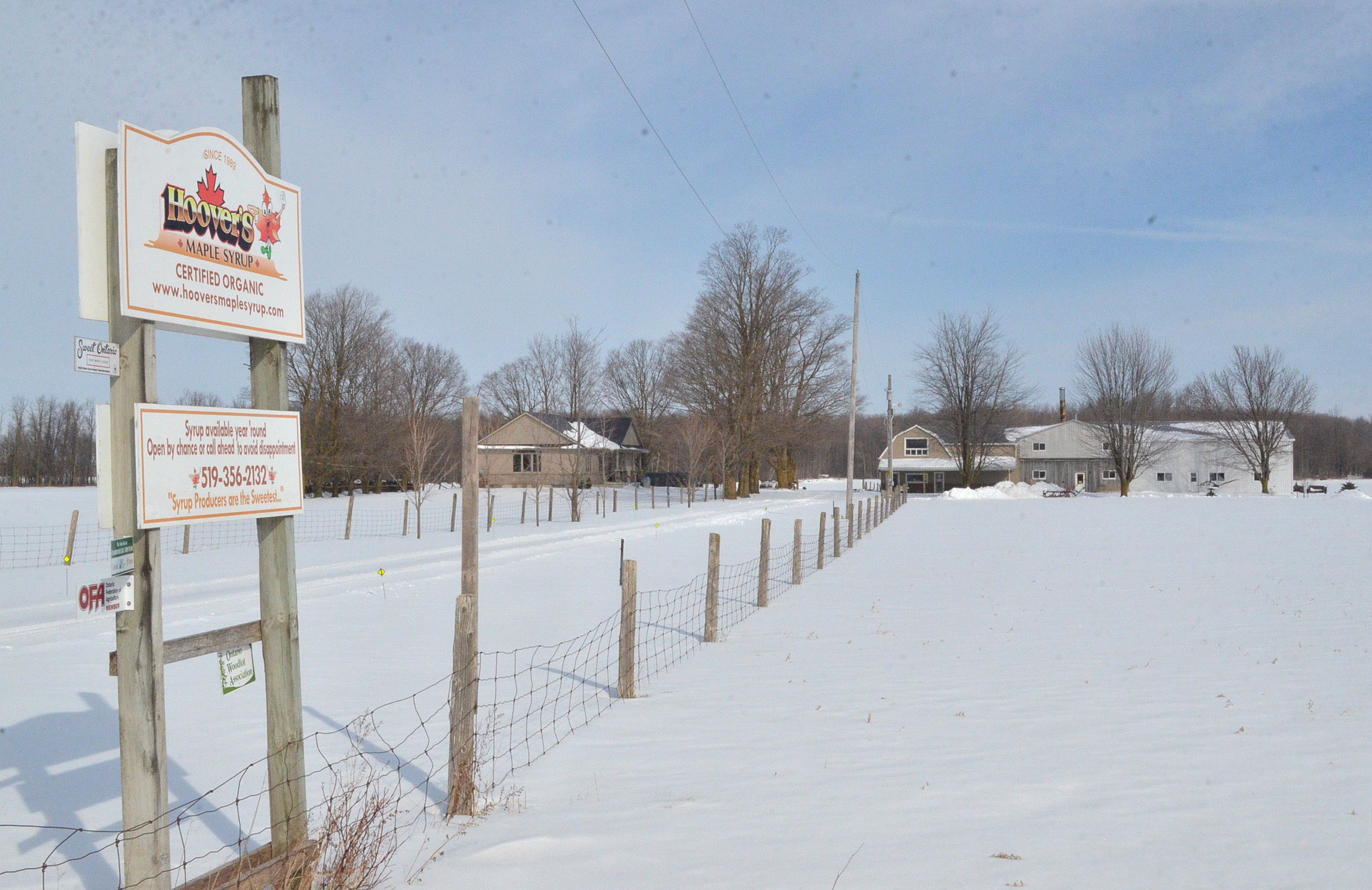
Hoover’s Maple Syrup, located on Line 78 in North Perth. (Dan McNee photo)
Hoover’s Maple Syrup has come a long way since Terry hung those first 300 buckets back in 1988. Pipelines soon followed the next year, and the Hoovers began adding a couple hundred taps in each subsequent season. Their operation now features 2,400 taps and 11 kilometres of pipeline, with the end result typically yielding around 3,000 litres of syrup annually.
But every year is completely different, and maple syrup producers are often at the mercy of Mother Nature. The sap can run anywhere from mid February to mid April, with the optimal temperature being about minus-five Celsius at night, and plus-five Celsius during the day.
“Years ago, you never tapped until March Break. That’s just the way it was,” says Terry, clad in a knitted blue toque, plaid work coat and insulated rubber boots. “Now, if you don’t tap until March Break, you’ve lost half your year.
“You’re shooting at a moving target.”
Preparation and Forestry
Keeping that moving target at the top of mind, producers like Hoover must always be prepared. Throughout the off-season, much of Terry’s daily routine involves forestry measures and bush upkeep. The sugar bush must be continually thinned and cleared of dying or dead stock, so that come the early spring, the pipelines and their precious cargo are able to run unhindered.
“That’s the work. Then you put in your main line and your lateral lines,” said Hoover, explaining that there is typically 2-3 weeks of cutting involved before 2-3 days of pipeline extension can be made. “As one guy explained to me, forestry is like gardening – except that you use a chainsaw instead of a hoe. You’re always improving, you’re always cutting out your weeds, you’re cutting out your split-off trees.”
A layman might think that a sugar bush would only contain maple trees to maximize potential sap production, but that’s not the case. Hoover’s sugar bush is also filled out with species like beech, black cherry and ash. The reason for this simply comes down to overall health.
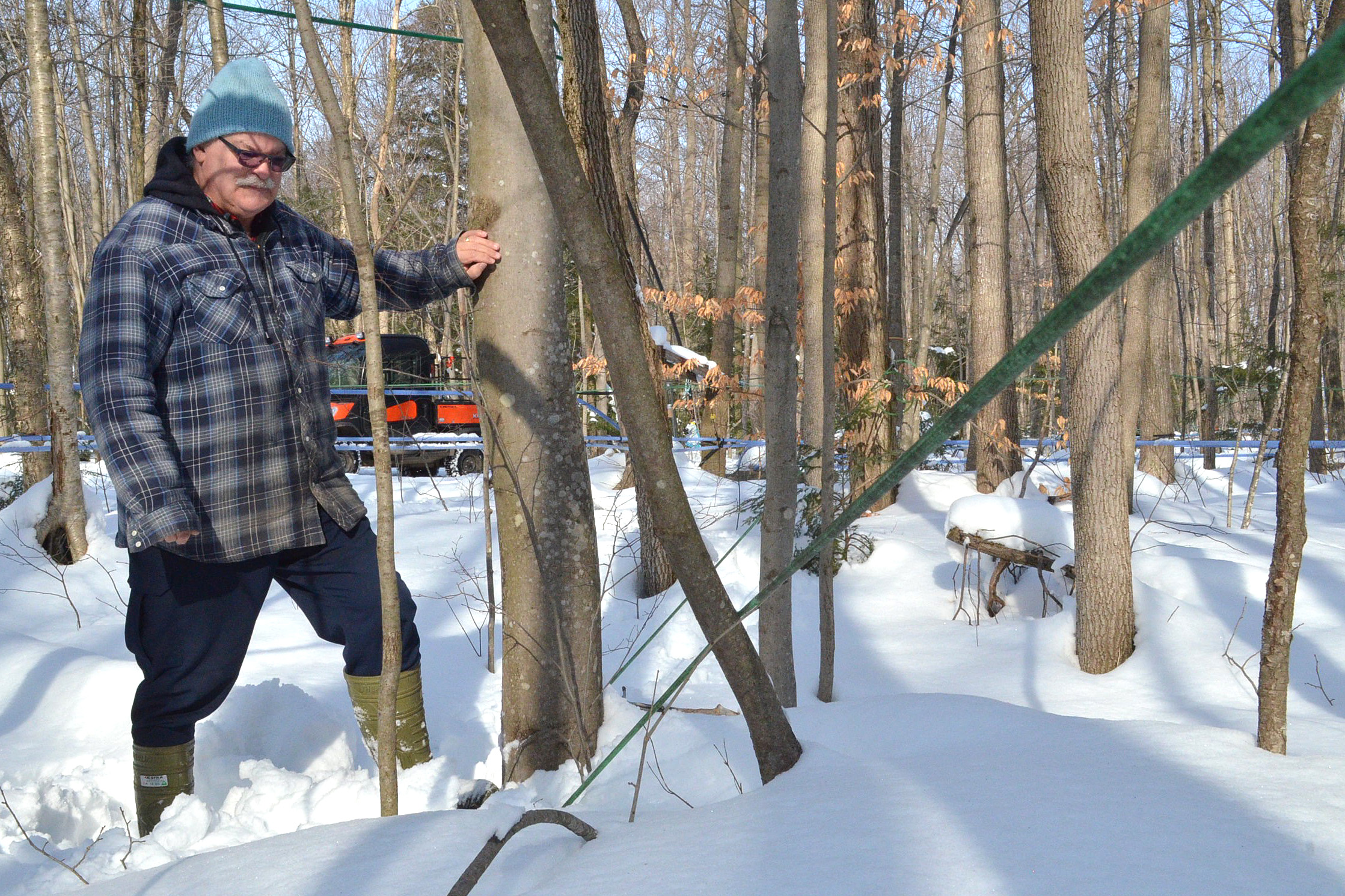
Terry Hoover clears a line obstruction. (Dan McNee photo)
“You want biodiversity. You do not want just pure maple,” said Terry. “It’s a lot healthier, your forest is a lot healthier. Plus if you happen to get one disease, it’ll just wipe out the whole thing. It’s better genetics.”
Invasive species like the emerald ash borer have become prevalent in the Hoover sugar bush, and have taken their toll on the ash population present. Falling one ash tree means around 100 branches for Terry to clean up; if he waits until a tree is completely dead that count becomes closer to 1,000 branches.
And very little goes to waste after those seemingly endless tree cleanups. Hoover’s wood-fired evaporator requires approximately 14 bush cords to operate throughout a given season.
The final weeks leading up to the sap running also requires Terry and Diane to service and clean their equipment.
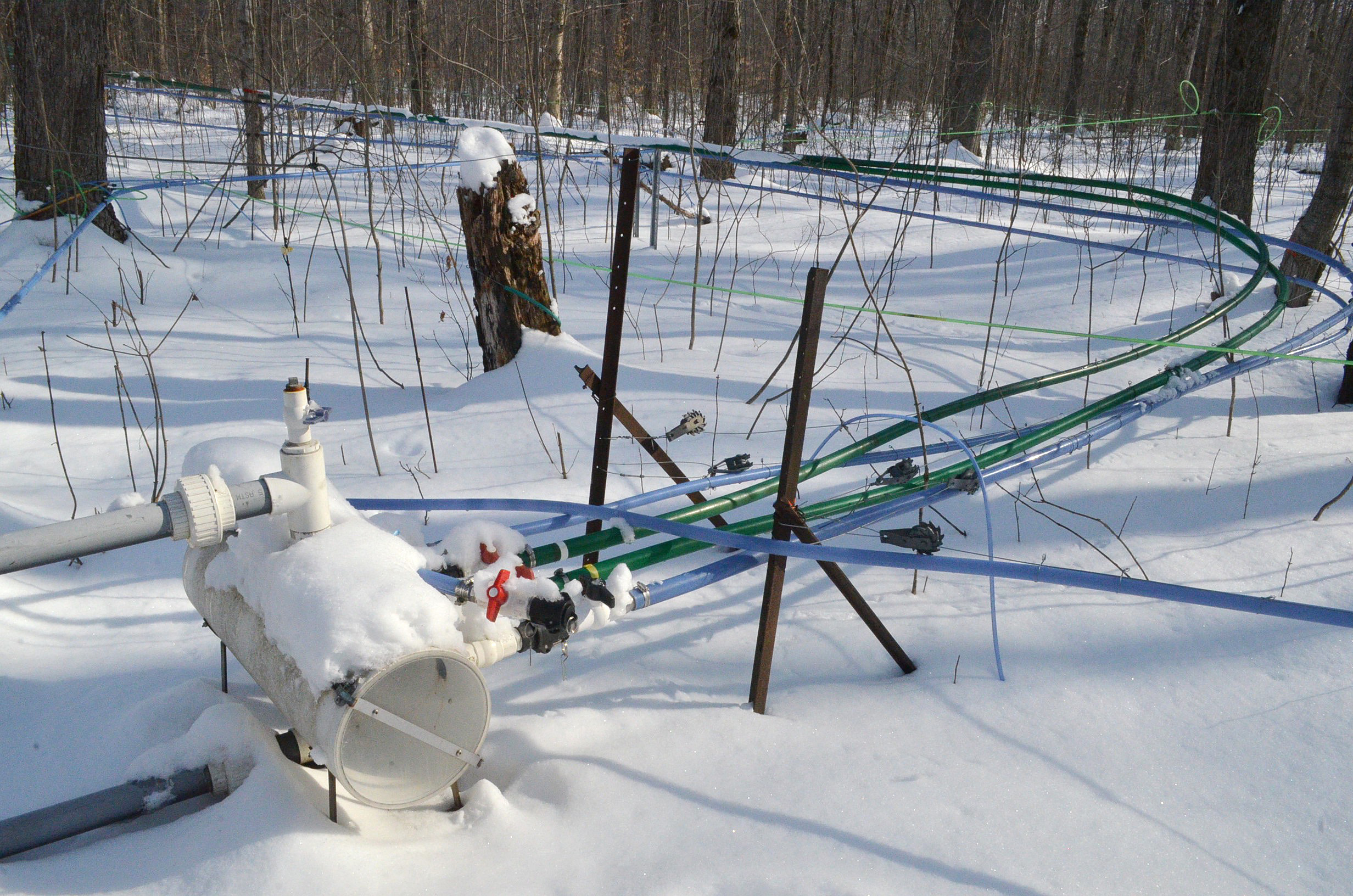
A sap ‘booster,’ which allows the liquid to make an uphill journey to Hoover’s sugar shack via vacuum. (Dan McNee photo)
“We have to service the vacuum pump, clean and put together the sap extractors, inspect and wash all storage tanks (we do this at the end of the season, but do a fresh wash to start the new season), flush the mainlines with a mixture of air and water; we inspect the membranes and put together the reverse osmosis machine and then it has to be washed and cleaned before we start processing sap, and finally we put together the evaporator to do a test boil with water to kick off the 2022 season,” explained Diane via email.
“All of this ensures that we produce a quality product for our customers. We take great pride in our certified organic maple syrup and we say, ‘only the best for our customers.’”
Tapping Timeline
Hoover’s Maple Syrup utilizes 16 mainlines of piping which must be replaced every 15 years for peak efficiency – prior to the 2022 season Terry replaced nine of them. Feeding those mainlines are countless lateral connecting lines; quite remarkably, much of the sap collected from the tree taps makes its way uphill to the Hoover ‘sugar shack’ 500 metres from the bush. This is achieved after the sap is collected in a rear dumping tank, then transported to a ‘booster’ at the front of the bush, and pushed through the rest of the way via the reverse slope to the shack, where its final transformation begins.
Technology has significantly aided the Hoover operation over the years. Each mainline is now outfitted with a monitor that alerts the main computer at the sugar shack if there is any sort of obstruction in the line or issue with the vacuum. While each monitor doesn’t come cheap at several hundred dollars a pop, Terry says it’s just another worthwhile investment towards maximizing the final yield and allowing him to do his job more efficiently. Producers must take hold of every advantage they can get.
“It’s just another tool in your toolbox,” he said.
This year, after receiving first tree-tapping hosting honours for the Waterloo-Wellington Local of the Ontario Maple Syrup Producers’ Association (OMSPA) on Feb. 25, the Hoovers had half their trees already rigged for collection; by the end of that weekend they were all ready.
The general rule of thumb is to have everything ready to go by the last weekend in February, but again, there are many uncertainties when it comes to the sap season.
“She’ll mix things up like you wouldn’t believe,” said Terry of Mother Nature’s apparent ‘sense of humour.’ “You have to be prepared. Roy Martin told me years ago, he said ‘one of the things that remains consistent about maple syrup from year after year is its inconsistency.’ You have to expect the unexpected.
“Never cut corners, or the maple gods will bite you in the ass. And that is so true.”
Sap Collection, Syrup Production
Just over one week after the Hoovers hosted the first-tapping ceremony, Terry was completing his first evaporator boil of 2022. Based on this early March timeline, the taps will likely be pulled sometime in early April. The Hoovers’ earliest boil happened a couple years back on Feb. 17; its latest ever was March 17.
The Hoover lines bring in approximately 200-250 gallons of sap per hour, with about 40 litres of sap required to make one litre of maple syrup. When Terry first began his syrup operation in the late 1980s, he was able to access around 0.75 per cent of a given tree’s total sap, with the average being about one per cent. He explained that this was due to the bush being denser at that time, along with smaller trees to draw from. The Hoovers have since improved that number to 1.5 per cent.
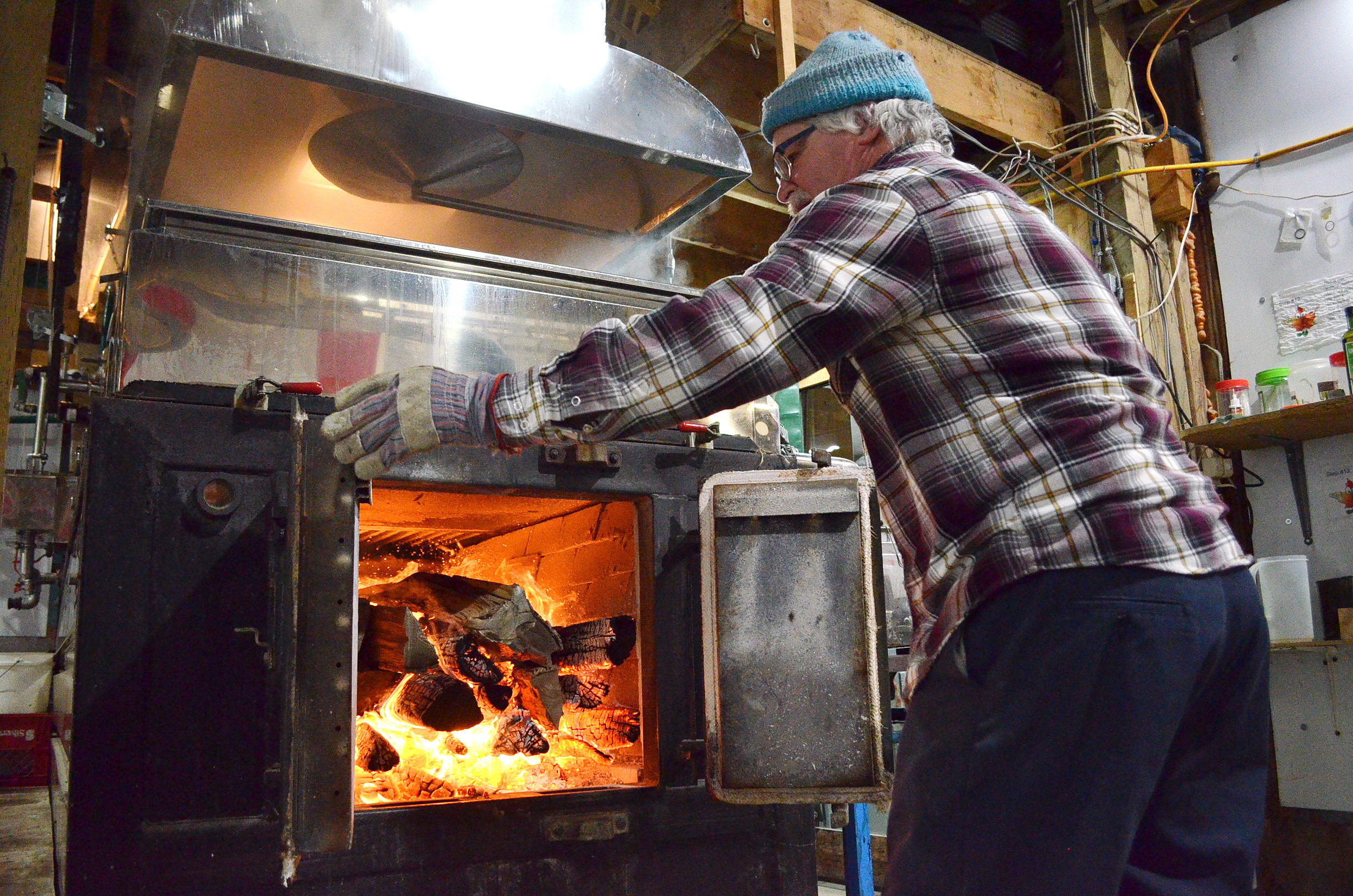
Terry Hoover keeps the wood coming to maintain a boiling temperature in his evaporator in late March. (Dan McNee photo)
“That may not seem like much, but it’s huge in the maple world,” he said, relating maple sap collection to a human giving blood, with about 250 gallons of sap going up a maple to sustain it and about two gallons being removed for syrup production annually. “Everybody thinks, oh, we’re killing the tree. We’re leaving 248 gallons to that tree to grow. We are not hindering it at all.”
Each evaporator boil is not exactly cut and dry, either. After sap is placed in its four quadrants atop the huge contraption, variables such as altitude and atmospheric pressure that day can affect the evaporator’s optimal boiling point. On March 23 during boil No. 8, Terry’s target temperature was a very specific 216.8 degrees Fahrenheit. To maintain that kind of heat to achieve the level of evaporation required, more wood must be added to the equation every eight minutes. Quite literally like clockwork.

The evaporator does its work, bringing sap to its boiling point and eventually the unfiltered syrup close to the final product. (Dan McNee photo)
At that point of the eighth boil last week, the Hoovers had already successfully harvested over half of their annual target yield. All of the accumulated sap waits patiently in storage tanks for its turn in the evaporator. After it is boiled, it is filtered, cooled and bottled for sale.
“Seeing something right from the beginning through to the end is a fascinating thing,” said Terry. “You tap the tree, you thin the tree, you improve the forest. You boil the sap down, you filter the syrup. You do everything.
“It’s an art. This is the first crop on the farm (every year), maple syrup.”
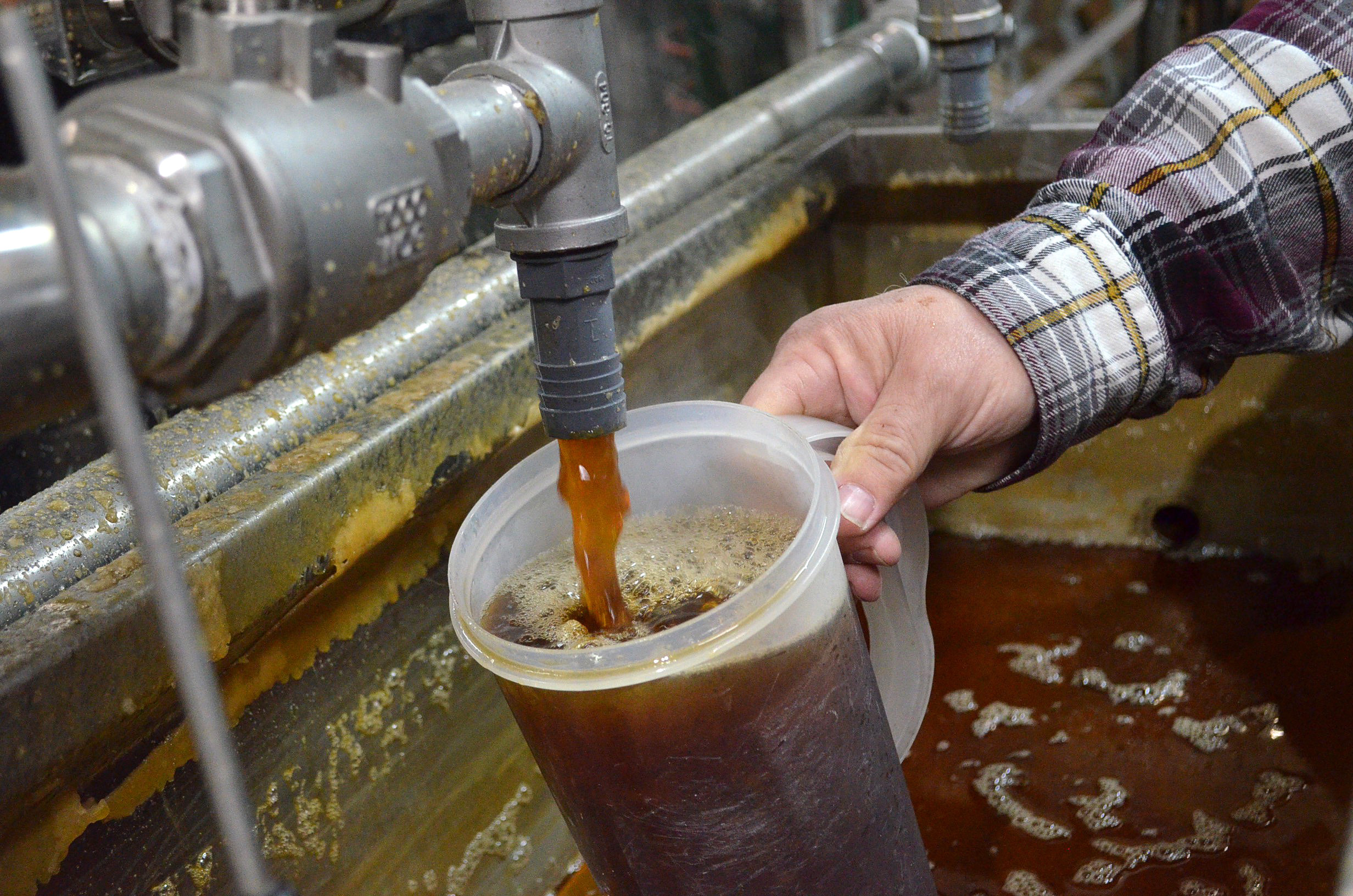
Unfiltered product drawn out of the evaporator. (Dan McNee photo)
Proficient Producers
2020 was a very big year for Hoover’s Maple Syrup. That January, Terry and Diane were presented with OMSPA’s most prestigious honour, the Albert and Ruby Martin Award, recognizing their outstanding contribution to the provincial maple industry.
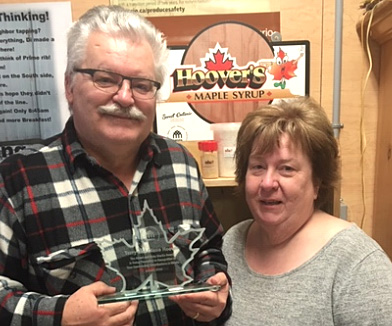
Terry and Diane Hoover receiving the prestigious Albert and Ruby Martin Award in 2020. (Submitted photo)
They followed that up by winning the Elmira Maple Syrup Festival Producer of the Year Award for 2020 – an honour that Terry jokes is three years running because of the cancellation of the two subsequent festivals due to the pandemic.
“All of a sudden you realize that you made it – you’re in that group,” he said of being included with the best of the best in one of the top maple syrup-producing regions of the world. “Before you looked up to them, and now you’re even with them. It solidified everything.”
Maple Weekend, April 2-3
While most of the spring season is of extreme importance to every producer, the first weekend of April stands above the rest.
Most OMSPA members celebrate Maple Weekend, and it’s an event that is especially anticipated every year by Hoover’s Maple Syrup. On Saturday, April 2 and Sunday, April 3, Terry and Diane welcome in the public to see their certified organic operation firsthand and how maple syrup makes its complete transformation – from tree to table. And no visit would be complete without getting the opportunity to taste their award-winning product atop its perfect running mate, that of course being pancakes.
Maple Weekend tours can be booked online by visiting hooversmaplesyrup.com.
***
2022 will be another big year for the Hoovers – it marks Terry and Diane’s 20th wedding anniversary.
Now in his early 60s and when asked about his potential future retirement plans, Terry admits he hasn’t given much thought to the subject. He and Diane are content to continue chasing maple syrup perfection, although one could argue that they may have already achieved that notion given recent accolades.
And perhaps Terry just hasn’t set that retirement date yet because in case you haven’t heard, those in his profession actually enjoy a sense of immortality.
“Maple syrup producers never die, they just evaporate,” he laughed.


